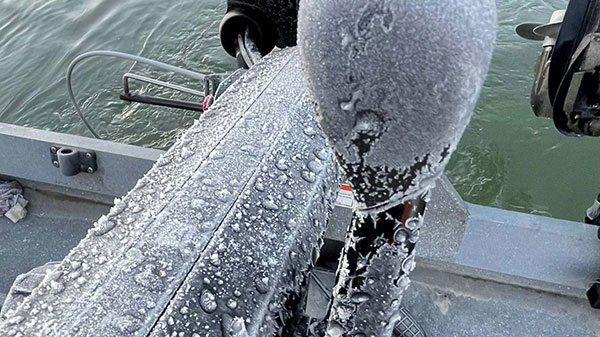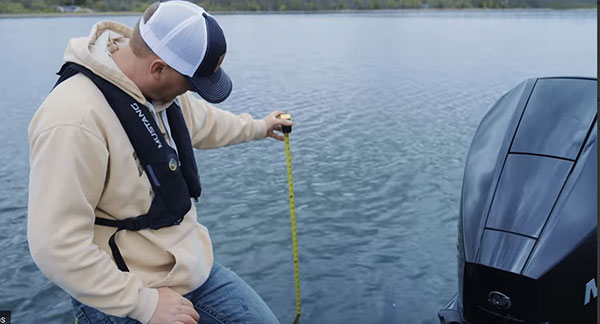- Details
Boat US Report
Now that recreational boating is coming to a close in much of the country, BoatUS takes a look back at the Top 10 boat names ordered this season through its online boat graphics service and provides some commentary.
- Andiamo: Meaning “let’s go / we go / come on” in Italian, Andiamo remains in the No. 1 spot from last year’s list. It’s also a happy refrain heard from the person behind the helm as they put the throttle down and head to open waters.
- Osprey: This year marked the premiere of Osprey, having never before made the top 10. In a unique twist, Osprey bumped last year’s No. 2 boat name, Social Distancing, completely off the list. ‘Nuff said, right?
- Serenity: This No. 3 name is so popular it has made the top 10 seven times since 2010, tying the record with Second Wind. Yep, you guessed it – both are popular with sailboat owners.
- Details
Mercury Report
 Boat winterizing
Boat winterizing
The holiday season is fast approaching and, while most boaters in your neighborhood have winterized and stored their boat and engine until spring, you still have some late-season fishing and/or hunting on your to-do list. Several sections of the US offer outdoor activities late in the year – and all Mercury Marine outboards are rated to operate at temperatures as low as -15C/+5F.
However, no matter how invigorating late-season boating can be, you'll need to ensure your outboard and boat are ready to withstand the cold. Before you set the alarm clock for early tomorrow morning, keep these facts and recommendations in mind.
- If you have a FourStroke outboard, check the owner's manual for advice on proper oil viscosity for cold-weather operation.
- The most common cold-weather outboard problem is something many hunters call "duck hunter's freeze-up," which occurs when a hunter in the winter months tilts up the outboard to keep it out of marsh muck or to pull their skiff ashore. Tilting up the outboard traps water in the motor, which freezes if the air temperature is low enough. Frozen water in your outboard almost always results in serious engine damage.
REMEMBER: When the air temperature sinks below freezing, always keep the motor in its down position when it's not running.
- After each outing, pull the hull drain plug in your boat and tilt the bow up to allow all water to drain from the bilge.
- And after you've taken your last boating trip of the season, don't forget to winterize appropriately, including these basic steps:
- Gasoline containing alcohol (ethanol or methanol) can cause the formation of acid during storage and can damage the fuel system. If you use gasoline that contains alcohol, drain as much of the remaining gasoline as possible from the fuel tank, remote fuel line, and engine fuel system.
- Then fill the fuel tank and engine fuel system with treated (stabilized) fuel to help prevent the formation of varnish and gum.
Following these simple tips – and the advice offered in the owner's manual for your engine – will keep you boating longer now and in the coming spring.
*Also, don't forget to protect yourself with the appropriate cold-weather gear and clothing. ALWAYS wear a lifejacket, and during cold weather consider a float coat and protective bib pants. If you fall into cold water, you have just a few moments to get back on board before your mobility starts to decline. Think about cold-water reboarding as an important part of your preparations.
- Details
Yamaha Outboards Report

When Frank Wilhelm visited his house on Lake Norman last winter, he walked out to the dock and hopped on his Suncatcher® pontoon, thinking he would run his Yamaha VMAX SHO® 225 for a while to keep it in mid-season form. But when he turned the key…nothing…no trim, no lights and never mind turning over, the starter wouldn’t even click. He had the battery on a trickle charge so he knew it had juice and figured the problem was something simple like a blown fuse so he took it to the local shop for a diagnosis.
The Worst Phrase a Boater can Hear
A while later he got a call and heard the words all boaters dread: “I’ve got some bad news.” As it turns out, muskrats had chewed the rubber off his wiring harness and transducer wire like they were ears of corn, and the estimate to fix it was in the thousands of dollars because once the wires within are exposed, everything shorts out. What was weird is the destructive ‘rats didn’t touch the wiring harness coming from the engine because it stayed underwater in the splashwell. Instead, they had found egress through a small opening in the rear of the center pontoon he didn’t know existed. Wilhelm noticed the muskrats didn’t touch his bass boat, which was on a lift so part of the solution was to do the same for his pontoon. He also sheathed the repaired wires in stainless steel mesh and fabricated a screen to close off the opening in the pontoon.
Unfortunately, boaters aren’t the only ones that love boats. There’s a lengthy list of other critters that find boats irresistible. Some want to chew, others want to move in, burrow or leave deposits aboard your pride and joy. Learning how to discourage them requires preventative steps specifically targeted toward the pests in your area. If you are new to an area or boating, it’s a good idea to ask around to see what lurks in and around the waters you will frequent.
- Details
Mercury Report
 Boat owner calibrating depth finder
Boat owner calibrating depth finder
The vast array of marine electronics available these days is simply amazing. Quality, high-functioning products that can do just about anything can be easily found, making this an exciting time to be a boater.
However, that’s not to say that you can just plug them in and expect them to be set up for optimal performance on your boat right out of the box. You’ll want to read your owner’s manual first to make sure you understand all the basic functions of a given piece of equipment, so you can get the data you need, when you need it, without doing a bunch of trial and error in a moment when it might not be convenient to do so. Some items, like a depth finder, might also need to be calibrated.
But if you buy a new depth finder, why would it need to be calibrated? Wouldn’t it be adjusted correctly at the factory? The answer is no, actually, there’s no way anything that measures the depth of the water can be accurate without some adjustment. That’s not a big deal when the unit says you’re in 50 feet of water, but when it says you’re in 2.5 feet of water it could become a very big deal.
The reason for this is that the transducer – the transom-mounted part of the system that sends and receives sound waves off the bottom of the body of water – may be located at varying depths below the waterline, depending on the type of boat and installation method. If you don’t calibrate the unit to account for the distance the transducer sits below the waterline of the boat, you won’t get an accurate reading.
Fortunately, the team at Wired2fish has put together this easy-to-follow Mercury Quick Tip video that shows you just how to do it. All you need is a tape measure, notepad, writing utensil and perhaps the owner’s manual for your depth finder. Then just follow these simple steps:
- With your boat on its trailer, go to the transom of your boat and locate your transducer. Measure from the waterline (usually visible in the form of a slight stain that can be seen going across the transom and/or outboard bracket) to the bottom surface of the transducer. This doesn’t have to be extremely precise, but the more accurate you can be the more accurate your depth readings will be. Record the measurement on your notepad.




